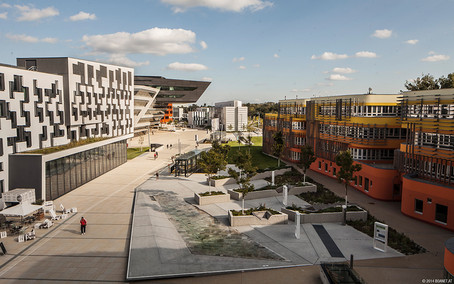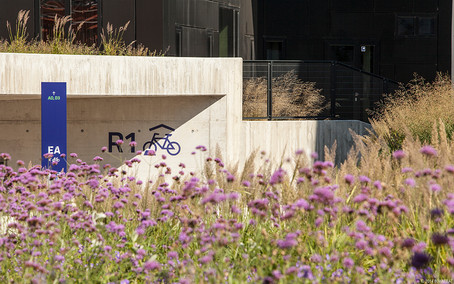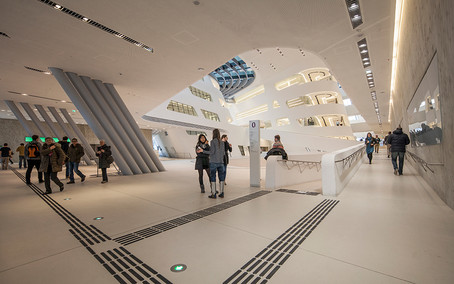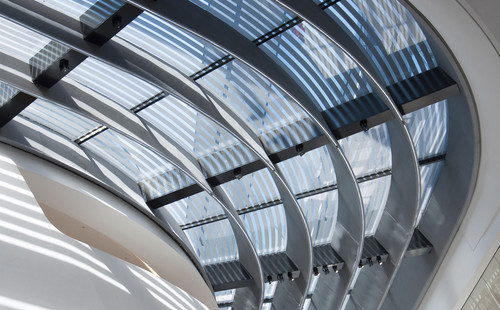Architecture & Buildings
University of the Future
Internationalism, innovation, diversity – the new Campus WU is the concrete realization of WU’s vision for a modern university. The fundamental principles of the new architecture reflect the values and ideas we cherish at WU.
As a public institution, WU has lived up to its responsibility of building its new campus in an economical, ecological, and socially sustainable manner. WU’s decision to locate the new campus in Vienna’s second district will redefine this area and transform it into an educational hub. We have not only constructed new buildings, but in the process we have also given concrete realization to our ideas of what the university of the future should look like. The new campus is more than just a place for academic research and teaching and learning practical skills; it is also designed to create a new space for social, cultural, and political life.
The imposing Library & Learning Center (LC), designed by the Iraqi-British architect Zaha Hadid, is a testament to the central importance of research and teaching at WU. The Library & Learning Center is surrounded by five building complexes, including the Teaching Center, which houses most of WU’s auditoriums. The Teaching Center is intended mainly for bachelor degree students, while the master degree programs are taught primarily in the individual Department buildings. The Executive Academy building is the home of continuing education and life-long learning programs. In this way, the various buildings and their functions reflect the three tiers of teaching and learning represented by the Bologna Process.
WU’s Department-based organizational structure was also a contributing factor. In the past, the various Institutes that make up the Departments were scattered across different locations. Now they have been brought together in four Department buildings, which will make life much easier for both students and faculty.
These are not the only improvements the new campus has to offer: All rooms have natural light, and the auditoriums feature state-of-the-art teaching equipment, including digital whiteboards. There are 3,000 student workplaces, three times as many as in the old buildings in Vienna’s ninth district. These workplaces are located not only in the dedicated self-study areas, but also in project rooms that can be booked by teaching staff and students alike. They cater to different needs by providing quiet spots for focused academic work as well as opportunities for work on group projects in communicationfriendly study areas.
The top priority in planning the new campus was to create an environment for WU students and staff that is conducive to productive work and communication.
Not only the buildings themselves, but also the surrounding grounds offer plenty of opportunities for communication and meeting people. 55,000 m² of Campus WU’s total 100,000 m² of floor and surface area is open, publicly accessible space. Fences or barriers would contradict our vision of an open campus.
Visitors and area residents are more than welcome at Campus WU. The campus offers not only food for thought, but also restaurants, cafés, and shops, all in a stimulating architectural environment.
As different as they may look, however, the buildings are all based on the same overall technical concept: the building infrastructure is standardized in terms of construction, energy supply, ventilation, and sanitary facilities. The entire campus has been designed in accordance with “green building” principles. Much of the required energy is obtained using geothermal energy from groundwater.
Another key feature of Campus WU is barrier-free accessibility. All auditoriums are specially equipped for people with disabilities, all areas are designed to be wheelchair accessible, and the campus also features a tactile guidance system for the visually impaired.
We have not only made sure to comply with all relevant legal guidelines, but we have also drawn on experience gained from best practice examples. WU aims to play a pioneering role – in all respects.

Award-winning Architecture
The architecture of Campus WU is not only popular with visitors, it also receives accolades from the juries of national and international architecture competitions.
The architecture of Campus WU is not only popular with visitors, it also receives accolades from the juries of national and international architecture competitions. In the spring of 2014, the six building complexes that make up the campus received the Schorsch Award, presented by Vienna’s Municipal Department for Architecture and Urban Design (Municipal Department 19). The City of Vienna presents the Schorsch Awards every year to honor outstanding architectural projects. The following summer, the renowned Architectural Digest magazine ranked Campus WU among the nine best new university buildings around the world.
The campus’ bold colors have not gone unnoticed, either: In October 2014, the orange-yellow D3/AD department and administration building, designed by Sir Peter Cook and CRABstudio, won the Innovative Use of Colour on Exteriors Prize at the World Architecture Festival in Singapore.
The D3/AD complex and the WU Library & Learning Center also received the prestigious RIBA European Award, presented by the Royal Institute of British Architects.
Vienna-based architects BUSarchitektur received the E. A. Plischke Award for the TC/D1 buildings, the Campus WU master plan, and the grounds design in November 2014. In 2015, BUSarchitektur was also awarded the Premio CICA de Urbanismo in urbanism by the International Committee of Architectural Critics (CICA).
The campus’ innovative guidance and orientation system, designed by buero bauer, was distinguished with the Red Dot Award. The campus orientation system combines analog, digital, tactile, and acoustic media to make Campus WU accessible to all.

Sustainable Campus
Sustainability – including economical, ecological, and social aspects – was a main priority in the planning and construction of Campus WU. In 2019 WU’s campus became Austria’s first climate neutral university campus.
Green Buildings
The entire campus was built based on Green Building principles. These principles include:
Minimizing life-cycle costs
Using highly durable building materials and constructions
Energy efficiency
Using local, renewable energy resources
Landscaping concepts
Use of geothermal energy for heating and cooling
Use of solar energy
Socio-cultural factors: accessibility, health, and safety
In 2015, the Austrian Sustainable Building Council (ÖGNI) granted Blue Building certifications to all building complexes on campus: The Department Building 1 was awarded a gold certification, all other buildings silver.
The Blue Building concept takes Green Building standards to a new level. Unlike green buildings, where the emphasis is mainly on energy efficiency, Blue Building certification focuses on the needs of the buildings’ human occupants: People should feel comfortable living and working there. The certification is awarded based on transparent and standardized criteria, including ecological and economic standards, socio-cultural and functional aspects, and technical performance. The conservation of energy and resources is also evaluated, as is the degree to which the buildings meet economic and human needs.
The sustainable AR building is almost entirely energy self-sufficient. For this, it was awarded pre-certification in gold from the German Sustainable Building Council.
Pioneers in Environmental Management
WU promotes environmental awareness among its employees and students, supports environmentally friendly and sustainable activities, and encourages students, faculty, and staff to actively deal with sustainability-related issues, also in their research and teaching. To optimize and improve its environmentally relevant programs, WU has introduced an environmental management system pursuant to the regulation issued by the European Parliament (EMAS, ECO Management and Audit Scheme). WU also fulfills all the requirements for ISO 14001 (2015) and has had this additional environmental qualification confirmed through ISO certification.

Barrier Free Accessibility
All auditoriums are barrier free, all areas are wheelchair accessible, and a tactile guidance system is in place to allow the visually impaired to find their way around campus.
